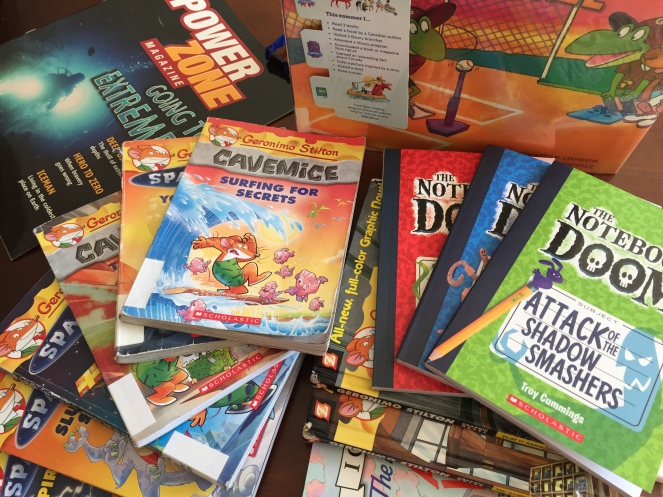As the new school year begins I find myself preparing to face three classes of reluctant readers. I am sure many of them will be feeling some anxiety and pressure as they enter my class for the first time this coming Tuesday. They won’t be alone.
After three years away from a traditional classroom, I will be returning to a regular timetable, predictable hours and a steady prescribed curriculum. I am nervous and anxious too! However that being said, I am looking forward to connecting with my grade 10s and 12s who will be motivating me each day to get up and help them to find their writing and reading groove.
In my seventeen years of experience as a classroom teacher I have seen many changes especially when it comes to Ministry expectations and trends in education. One thing that has not changed is the emphasis on reading and writing strategies; only the strategies have gotten smarter and better considering the teenage brain. Research tells us that teenagers need sleep and a lot of it (9-10 hours a night) to function and pay attention in class. For a classroom teacher and their students, the struggle is real. I have to motivate and encourage those sleepyheads to read and write as early as 8:30 a.m.! I’m in for a challenge because the students are already coming into the class with some pre-existing issues. From self-esteem, to functional literacy skills and learning disabilities I will have my hands full.
A few strategies that I have picked up along the way are from author Marilyn Reynolds. Reynolds first came to my attention at the beginning of my career as I was pursuing additional qualifications in Reading and Library. Her approach to education is very refreshing as she has over 30 years’ experience working with at-risk youth. Her book I Won’t Read and you Can’t Make Me: Reaching Reluctant Teen Readers published in 2004 is still relevant today. Reynolds has helped me tremendously when working with both at-risk students and those who are unmotivated.
Some strategies she uses with success (and that I have adapted myself) include:
- Respecting students including their experiences, attitudes and choices regarding what they choose to read
- Helping students become accountable for their actions
- Practicing reading and writing each day
I found that all the above strategies are incredibly helpful but the respect piece is most important for classroom success. In my years as a teacher I have learned that all these young people come from all walks of life and each person has their own story to tell (or not). This influences what is available to read in class.
 One of the strategies that I have implemented is to visit the library on a scheduled and predictable basis to refresh the book collection and change up our day-to-day scenery. I have students who only gravitate to graphic novels while others ask for specific authors that reflect a particular demographic like Sister Souljah’s Midnight series. Other students have asked for only non-fiction books like the Ripley’s Believe It or Not Series or yearly National Geographic Almanacs. I have also included Reynolds series of novels that she wrote that are geared towards young people including titles like Telling and Love Rules.
One of the strategies that I have implemented is to visit the library on a scheduled and predictable basis to refresh the book collection and change up our day-to-day scenery. I have students who only gravitate to graphic novels while others ask for specific authors that reflect a particular demographic like Sister Souljah’s Midnight series. Other students have asked for only non-fiction books like the Ripley’s Believe It or Not Series or yearly National Geographic Almanacs. I have also included Reynolds series of novels that she wrote that are geared towards young people including titles like Telling and Love Rules.
Further I found that timely feedback is so important to a reluctant reader and writer. Whether they have just finished their first journal entry or written a paragraph, my feedback is key. Students also like to be read to no matter how old they are. I will often choose a novel or non-fiction piece that we can read a little each day.
I had tremendous success several years ago when I chose to read the story of Steven Truscott to my class. At the time we were studying In the Heat of the Night by John Ball and I wanted the students to see that injustice can happen at any time and to any person. Real Justice: Fourteen and Sentenced to Death by Bill Swan was the perfect pick for that class at that time. Because I was working with so many students who had experienced troubled times like an arrest, they could relate to story. They were particularly outraged at the sentence Truscott received because of his age. I heard many of them exclaim, “That’s my brother’s age!” or “I was fourteen when I was accused of…” We followed up the unit with some media footage of Truscott who was acquitted 48 years later.
As I get ready to merge back into the classroom I hope to implement some if not all of these strategies with my three classes. The appeal to make it through the doors each morning with acceptance, respect and a treasure trove of reading materials that they may learn to love.

I love your philosophy on dealing with your students. With your strategies, you will hopefully instill a love of reading and writing in them. Is there a way that I can subscribe to your blog?
LikeLike
Hi Aunt Linda. Thanks for the positive feedback. 🙂 You should be able to click on a link to follow my blog. I can pm you via FB with instructions.
~Tracy
LikeLike